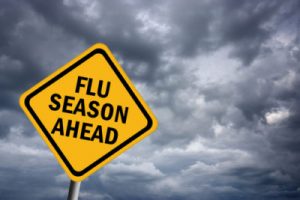Living through a pandemic has taught us many things, chief among them being that just when you think you’ve adapted to a new normal, it’s already changed. Viruses evolve, as do our responses. Today, we have a better understanding of how the virus spreads and vaccines that are effective and readily available. But we’re also facing more transmissible mutations like the Delta variant, causing many employers to reevaluate their mitigation strategies. In addition, people who were working remotely full time are now reentering the workplace, and new requirements from the federal government are challenging employers to determine how to vaccinate or regularly test their workforce or risk stiff penalties. All of this means employers are under more pressure than ever to help ensure a safe and healthy environment for their employees during a still-evolving pandemic. 
Adding to this pressure is the upcoming flu season, a seasonal viral illness with its own health concerns and one that has symptoms similar enough to COVID-19 and will potentially cause additional confusion and concern. The 2020 flu season was historically mild, almost certainly due to COVID-19 precautions such as masking in public, social distancing, and a large number of people working and learning from home. But many Americans are now back in the workplace (at least part time), kids are back in school, and some may not be taking the same level of precautionary measures, making it more likely the flu will be a larger concern in 2021.
Just as workplaces adopted guidelines to combat COVID-19 spread over the past year and a half, they will need to take the flu into consideration as part of their ongoing COVID-19 strategy. While every workplace is unique and has its own challenges and priorities, here are a few considerations employers can keep in mind to help keep their workforce healthy.
Communicate Clearly
Your employees most likely have their own questions and concerns about how to keep themselves, their families, and their coworkers safe as they return to the office or jobsite. Helping them answer those questions and better understand what they can and should do is critical for any employer deploying a robust COVID-19 strategy. More than ever, employers must be clear communicators to explain their policies related to COVID-19, what mitigation options they are taking, and what’s expected of those who are part of the workplace community. This will be especially critical as additional factors such as COVID-19 booster shots and flu season come into play and employers are tasked with helping their employees navigate the landscape. While the flu may seem more “mundane” than COVID-19, it still presents potentially serious health risks for certain populations and could lead to confusion and uncertainty—is it COVID-19, or is it the flu?
Make Vaccines Easily Available
Vaccines are the most reliable way to keep employees healthy and protected from both COVID-19 and the flu, especially this year. Epidemiologists believe that lower levels of flu infection in 2020 may lead to a lowered natural immune response to the 2021 strain, meaning vaccines must play a larger role in flu mitigation.
The good news is that many will opt for vaccination; according to a recent CVS Health survey, 71% of Americans said they planned to get a flu shot this year. And a new poll shows that COVID-19 vaccine hesitancy has reached an all-time low, with 80% of Americans now saying they already had or would likely get the vaccine.
But making both COVID-19 and flu vaccines easily accessible is the best way to make sure workers follow through on that intention. And when it comes to flu season, timing is critical: Public health experts agree that the best time to get your flu shot is before flu season begins and no later than the end of October. Employers should look to the benefits they offered to employees seeking COVID-19 vaccinations, such as on-site clinics, transportation assistance, and paid time off to receive vaccinations, to also help inform their approach to encouraging flu shots.
Testing Still Matters
While vaccines will be the first line of defense, on-site, employer-based testing can help quickly differentiate among employees with COVID-19, those with the flu, or those who may have symptoms for less concerning reasons such as the common cold or allergies. Having the ability to test rapidly on-site is critical to maintaining healthy employees, stop potential breakouts, and avoid losing time due to unnecessary health scares.
Smart employers will use a mix of these mitigation strategies to help keep employees safe, but it’s important to note there is no “one size fits all” solution. Business leaders must have a deep and thorough understanding of the unique needs of their workforce based on factors such as available resources, clinical recommendations, and employee preferences to help ensure a healthy and productive work environment during the upcoming flu season that will be compounded by a pandemic.
Potentially bringing your employees back to the workplace this fall presents a new and complex challenge. The first steps to ensure a healthy workplace must include preparation, consulting experts, and securing the right COVID-19 resources so you can support testing and vaccinations for your workforce. Despite the ever-evolving state of the pandemic, these approaches will enable you to be a trusted partner to your employees. The more planning you can do now, the better prepared you’ll be to execute and optimize your strategy to help keep your organization safe.
James Margiotta is a senior executive at CVS Health with more than 30 years of experience helping clients navigate complex healthcare decisions. In 2020, Margiotta was chosen to lead CVS Health Return Ready, a return-to-work testing and vaccine solution designed to help employers and institutions of higher education bring employees, students, faculty, and staff back to work safely during the COVID-19 pandemic.
